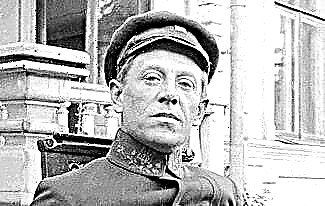SMERSH (short for "Deathbe wpeonies! ") - the name of many independent counterintelligence organizations in the USSR during the Second World War (1939-1945).
- The main counterintelligence department "Smersh" of the People's Commissariat of Defense - military counterintelligence, headed by Viktor Abakumov. Subordinated directly to Joseph Stalin.
- Counterintelligence Directorate "Smersh" of the People's Commissariat of the Navy, headed by Lieutenant General Pyotr Gladkov. Subordinated to the People's Commissar of the Fleet Nikolai Kuznetsov.
- Counterintelligence department "Smersh" of the People's Commissariat of Internal Affairs, head - Semyon Yukhimovich. Subordinated to the People's Commissar Lavrenty Beria.

History and activities of Smersh
The main counterintelligence department "Smersh" of the People's Commissariat of Defense of the USSR was created on April 19, 1943. By that time, Nazi Germany had suffered a crushing fiasco in the legendary Battle of Stalingrad. It was then that the initiative in the war passed to the Red Army.
At the same time, the Germans began to resort to new methods of fighting. The Nazis began to pay great attention to reconnaissance and sabotage activities in the Soviet rear. The Smersh employees had to confront this threat.
By the decision of the State Defense Committee, SMERSH was formed through the reorganization of the Office of Special Departments of the NKVD. The immediate leader of "Smersh" was subordinate exclusively to the People's Commissar of Defense Stalin. Accordingly, at the local level, the Smersh bodies were subordinate only to their superiors.
Thanks to such a system, Soviet counterintelligence was able to carry out tasks in the shortest possible time, since it was not pressured by other higher authorities.
Against spies and traitors
SMERSH tasks looked like this:
- fight against espionage, sabotage, terrorist and any other subversive activities of foreign intelligence services;
- verification of military and civilians who have been captured or surrounded by the enemy;
- the fight against anti-Soviet elements that have infiltrated the units and leadership of the Red Army;
- control of the entire front line in order to make it impenetrable for spy and anti-Soviet elements;
- the fight against traitors to the homeland in the ranks of the Red Army (collaboration, espionage, aiding the enemy);
- fulfillment of special assignments;
- the fight against desertion and self-harm at the front.
Due to the martial law, SMERSH agents were vested with great powers. They had access to documents and the right to search, interrogate and detain any suspicious person. General Viktor Abakumov was appointed head of Smersh.
For the first time "Smersh" showed great achievements during the Battle of Kursk. The Germans never managed to find out about the plans of the Headquarters of the Supreme High Command. At the same time, sabotage activities in the rear of the Red Army decreased significantly.
Broken Abwehr card
The Abwehr is a military counterintelligence body of the Third Reich. By the beginning of 1943, the Nazis were training agents to be deployed to the Soviet rear in about 200 German intelligence schools. However, thanks to the highly professional actions of SMERSH, the Germans were not able to seriously influence the course of the war.
In the same 1943, the Nazis planned to deploy a large-scale civil war in Kalmykia, the North Caucasus, Kazakhstan and Crimea. The Abwehr employees intended, with the help of local nationalists, to stab the Soviet Union in the back.

It is important to note that during the war, thousands of Crimean Tatars, Chechens, Kalmyks and other peoples fought against the Red Army. And yet the fact that the individual gangs did not reunite into one army was ensured by the Smersh forces.
Soviet counterintelligence often resorted to the so-called "radio games" - the transfer of deliberately false information to the enemy with the help of captured agents. During the war years, 186 such radio games were held, which almost completely blocked the Nazis' access to classified information.
SMERSH filter
Historians, describing the activities of SMERSH as a punitive and repressive body, emphasize the "filtering" of former prisoners of war. During such purges, officers allegedly ruthlessly dealt with the prisoners, sending them to notorious camps.
However, this is not quite true. It goes without saying that in the actions of counterintelligence officers periodically there were "mistakes", but still it was impossible to do without it. They had to carefully check each prisoner, since any of them could turn out to be a potential deserter, and therefore a traitor to their homeland.
There are many known cases when prisoners of war were restored to their ranks, and also provided them with medical and material assistance. At the same time, Smersh employees were often able to obtain evidence that this or that prisoner was a spy.

At the same time, even when traitors were identified, the counterintelligence officers did not arrange lynching, but handed them over to investigators for further investigation. Objective statistics say that the overwhelming majority of Soviet citizens who were "filtered" were not arrested or persecuted.
It is safe to say that SMERSH was not engaged in targeted political repression, although sometimes mistakes were made that led to exiles or deaths of prisoners.
Brief summary
During the Great Patriotic War (1941-1945) "Smersh" neutralized about 30,000 enemy agents, over 3,500 saboteurs and 6,000 terrorists. Approximately 3,000 agents worked behind enemy lines.
More than 6,000 counterintelligence officers were killed in battles and in the execution of special missions. In 1946 SMERSH became part of the Ministry of State Security as its 3rd Main Directorate.
A lot of films and serials based on real events have been filmed about the activities of Smersh. Today, there is still heated debate among historians about the activities of this formation. Some accuse counterintelligence agents of inappropriate brutality, while others argue the opposite.









